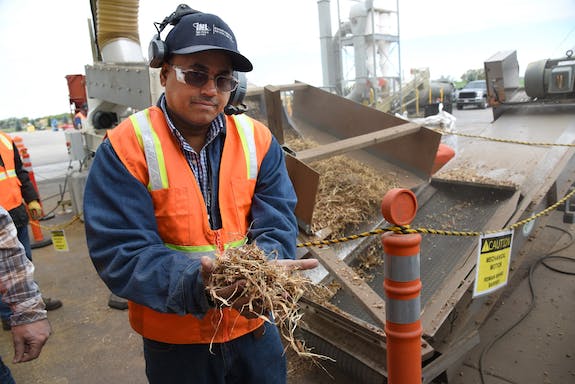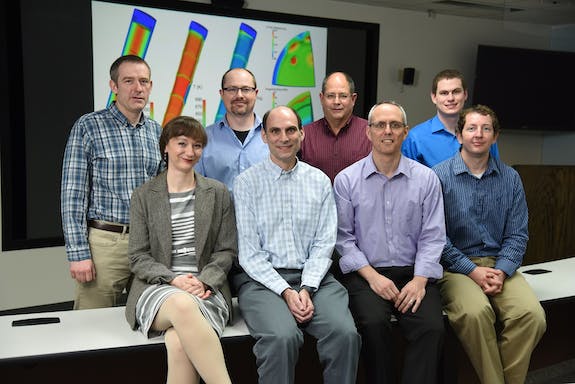Researchers from Idaho National Laboratory are well represented this year among the finalists for the 2018 R&D 100 Awards, sometimes referred to as the “Oscars of Innovation.”
Since they were started by R&D Magazine in 1963, R&D 100 Awards have identified and celebrated the top technology products from the public and private sectors. The U.S. Department of Energy’s national laboratories typically have dozens of finalists every year. This year, there were 60 finalists from 13 national labs, with 11 coming from INL.
Winners will be announced in November at a banquet in Orlando, Florida.
The following are finalists from INL:
Phosphate Sponge
Jack Law, Troy Garn and Mitchell Greenhalgh with Steve Hammon of Global Phosphate Solutions
The Phosphate Sponge provides an environmentally safe solution for remediating freshwater algae blooms caused by phosphate pollution from sewage treatment plants, animal feeding operations and fertilizer runoff. Filled with a proprietary powder developed by Rocky Mountain Scientific Corp., the beads in the Phosphate Sponge are made of an INL-developed sorbent material. When contaminated water is passed through a column or bed containing the beads, contaminants are absorbed by ion exchange. This reduces phosphate levels in water to merely a few parts per billion, sometimes even nondetectable levels. Like a sponge, the beads can also be “wrung out” and reused indefinitely, and the phosphates extruded from the beads can be recycled as fertilizer feedstock ingredients.
Battery Health Sentry
Sergiy Sazhin, Kevin Gering, Eric Dufek, David Jamison
The multibillion-dollar lithium-ion battery industry has lacked a fast, affordable method for detecting internal shorts in cells that can result in fires, explosions and toxic discharges. Using basic equipment, Battery Health Sentry offers the ability to detect self-discharge not just in single cells but within battery architectures consisting of several parallel strings. Rather than waiting for a measurement opportunity, Battery Health Sentry creates a testing opportunity by forcing a slight battery discharge at a small constant under-voltage, making a fast active measurement possible. The method can detect shorts long before a thermal runaway or catastrophic failure occurs. Conventional instrument hardware or battery management systems can be used with minor changes in software algorithms.
Electrochemical Recycling Electronic Constituents of Value (eRECOV)
Tedd Lister, Luis Diaz Aldana
Electrochemical Recycling Electronic Constituents of Value (eRECOV) offers a brand new solution to the growing challenge of electronic waste. The unique process incorporates an electrochemical cell to efficiently dissolve metals from cellphones, laptops and other devices, reclaiming precious metals (gold, silver, palladium) as well as ordinary but still valuable elements (zinc, lead, nickel and rare earths). The Environmental Protection Agency estimates that the United States generates nearly 3.5 million tons of electronic scrap annually, and that amount is growing each year. Most of it is exported to developing countries in Africa and Asia, yet the United Nations has estimated the value of materials that could be recycled from e-waste approaches $52 billion, including 300 tons of gold – roughly equivalent to 11 percent of the world’s gold production in 2013.
High-Moisture Pelleting Process (HMPP)
Jaya Shankar Tumuluru

Before biomass can become a large-scale energy commodity, it needs to be processed into a uniform product such as pellets. Yet this processing costs energy, which can drive up costs. Because the pelleting process generates frictional heat in the pellet die, Idaho National Laboratory researchers realized they could eliminate a drying step and save a significant amount of energy. Frictional heat generated due to compression and extrusion of the pellets drives off 5 to 10 percent of the biomass moisture. The pellets are then dried to about 9 percent moisture content in a low-temperature grain dryer, which is more energy efficient than a traditional rotary dryer. The High-Moisture Pelleting process offers a consistent quality bioenergy product at a fraction of the cost.
General Line Ampacity State Solver (GLASS)
Jake Gentle, Seth Hayes, Jacob Lehmer, Alex Abboud, Timothy McJunkin, Katya LeBlanc, Ben Fehringer, Kurt Myers and Gary Seifert, with Donna Rennemo and Catherine Meissner of WindSim, and Phil Anderson and Shane Wood of Idaho Power Company
Gathering data from the electrical power grid to improve its resilience and reliability, INL researchers observed that when the wind blew harder – and especially when it blew perpendicular to transmission lines – the cooling effect could increase transmission capacity up to 40 percent and even more where lines were in the same climatological areas as wind plants. GLASS (General Line Ampacity State Solver) is a Java-based software program that can help the end user determine, in real time, the limiting amperage capacities and thermal ratings for any given transmission line segment. This capability enables utility companies to use dynamic line rating (DLR) to adjust power production throughout their grid networks. Other methods for establishing transmission line capacity in real time rely on expensive line clearance and conductor temperature monitoring devices deployed on high-current spans. GLASS offers similar accuracy and resolution on a broader scale. Plus it is lower cost, lower maintenance and doesn’t require utilities to directly install sensors or monitoring equipment on the energized transmission lines.
Antenna Coupled THz (ACT) Film
Submitted with Dale Kotter of RedWave Energy, Inc.
Converting waste heat into power represents one of the largest opportunities for bringing greater efficiency and reduced emissions to the energy sector. Using nanorectifying antenna research from INL, RedWave Energy Inc. has developed Antenna Coupled Thz (ACT) Film capable of harvesting low-temperature waste heat at power plants. Each sheet of ACT Film is made of tiny, square, gold-wire rectennas embedded in polyethylene, plastic sheeting that can be used nearly anywhere. The ACT Film absorbs heat between 70 and 250 degrees Celsius and converts it to electricity. Conceivably, composite stacks of ACT Film could be engineered to be compatible with existing power plant designs and used to replace cooling towers. By recovering 20 percent of low-temperature waste heat at a typical power plant, the electricity generated would equal the amount produced by burning 112,000 tons of coal in a year.
BISON Modeling Code
Jason Hales, Richard Williamson, Albert Casagranda, Kyle Gamble, Russell Gardner, Wenfeng Liu, Stephen Novascone, Giovanni Pastore, Stephanie Pitts, Benjamin Spencer

BISON is a computer code that models how nuclear fuel will perform once it is inside an operating reactor. This is valuable information for managing existing operations and designing more resilient and efficient next-generation fuels. The BISON code makes advanced computing power more accessible to engineers who understand fuel properties but have previously lacked the computer science resources needed to create advanced simulations. Using data from experiments that have already been done along with engineering equations that describe physical properties such as thermal expansion or heat transfer, BISON can create powerful 2D and 3D fuel simulations that are truly predictive.
Multi-hazard Analysis for STOchastic time-DOmaiN phenomena (MASTODON)
Justin Coleman, Swetha Veeraraghavan, Andrew Slaughter, Chandrakanth Bolisetti, William Hoffman, Efe Kurt, Richard Martineau
When planning any large construction project – a bridge, football stadium or power plant – investors want to be apprised of possible risks. Breakthroughs in computing capacity have made it possible to calculate detailed risk factors for fire, flood and earthquakes. With respect to soil behavior and the propagation of waves in soil, factors that are essential to seismic design, simulation has always been approximate. MASTODON is a computer simulation program that brings radical changes to the seismic design process by using patented modeling and simulation methodology and realistic numerical models. It optimizes seismic design for both safety and cost by prioritizing the structural components that contribute most to safety while eliminating the possibility of expensive overbuilding. Combining seismic simulation, probabilistic risk assessment and design optimization, MASTODON can be used in the planning of any structure in which public safety and/or taxpayer money are at risk due to a possible seismic event.
Autonomic Intelligent Cyber Sensor (AICS)
Todd Vollmer, Craig Rieger, Milos Manic
Autonomic Intelligent Cyber Sensor (AICS) is an artificial intelligence breakthrough that can protect the nation’s critical infrastructure from devastating cyberattack. AICS works autonomously to give industries the power to quickly identify and divert hackers, using machine learning to identify and map industrial control systems. It can identify anomalous network traffic, alert operators and deploy virtual decoys to slow or halt hacking attempts. Following installation on an industrial control system and an initial learning phase, AICS automatically updates what it knows about a control system, adapting and remapping as it goes. AICS sets up and continually updates decoy virtual hosts – honeypots – to distract attackers from targets, giving asset owners the ability and time to gather information that can help identify both a hacking threat and a potentially compromised system.
On-Site Inspection RadioIsotopic Spectroscopy
Gus Caffrey, Kenneth Krebs and Jayson Wharton with Brian Milbrath, Glen Warren and Mital Zalavadia of Pacific Northwest National Laboratory, and Nathan Wimer of Lawrence Livermore National Laboratory

Since the adoption of the Comprehensive Nuclear-Test-Ban Treaty in 1996, the vision has been that all nations would one day eventually ratify it to guarantee the world’s collective safety and security with regard to nuclear weapons. The world is still waiting for full ratification, but when that happens – as millions hope it will – there will be a need for advanced tools to ensure compliance with treaty obligations. OSRIS – On-Site Inspection RadioIsotopic Spectroscopy – is a portable, rugged gamma ray spectroscopy and laptop computer system for nuclear explosion detection that can be taken anywhere in the world to perform precise on-site inspections. To satisfy the security concerns of treaty signatories – various countries may disagree about which radioisotopes at a test site raise security concerns – OSIRIS uses a “data filter” to limit the information it collects to 17 fission-product radioisotopes agreed upon by international technical experts.
All-Hazards Analysis (AHA)
Ryan Hruska, Kent McGillivary, Mary Klett, Shad Staples
All Hazards Analysis (AHA) is a dynamic real-time dependency analysis framework for critical infrastructure risk analysis. It identifies hidden dependencies and associated risks, giving decision-makers a comprehensive view of interconnected systems before taking action. It presents information in the form of nodes (infrastructure), links (dependency relationships) and specific properties. Because AHA continually learns, it can blend general and facility dependency profiles with new information and changing network structure. This allows for more detailed sector and consequent analysis than possible with other infrastructure modeling systems.





